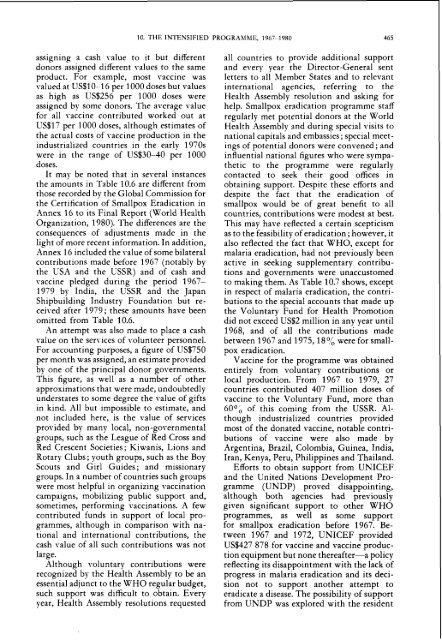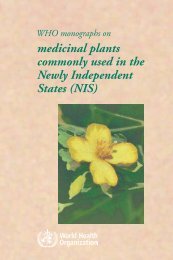smallpox eradication - libdoc.who.int - World Health Organization
smallpox eradication - libdoc.who.int - World Health Organization
smallpox eradication - libdoc.who.int - World Health Organization
Create successful ePaper yourself
Turn your PDF publications into a flip-book with our unique Google optimized e-Paper software.
10. THE INTENSIFIED PROGRAMME, 1967-1 980 465<br />
assigning a cash value to it but different<br />
donors assigned different values to the same<br />
L.<br />
product. For example, most vaccine was<br />
valued at US$10-16 per l000 doses but values<br />
as high as US0256 per 1000 doses were<br />
assigned by some donors. The average value<br />
for all vaccine contributed worked out at<br />
US017 per l000 doses, although estimates of<br />
the actual costs of vaccine production in the<br />
industrialized countries in the early 1970s<br />
were in the range of US$30-40 per 1000<br />
doses.<br />
It may be noted that in several instances<br />
the amounts in Table 10.6 are different from<br />
those recorded by the Global Commission for<br />
the Certification of Smallpox Eradication in<br />
Annex 16 to its Final Report (<strong>World</strong> <strong>Health</strong><br />
<strong>Organization</strong>, 1980). The differences are the<br />
consequences of adjustments made in the<br />
light of more recent information. In addition,<br />
Annex 16 included the ralue of some bilateral<br />
contributions made before 1967 (notably by<br />
the USA and the USSR) and of cash and<br />
raccine pledged during the period 1967-<br />
1979 by India, the USSR and the Japan<br />
Shipbuilding Industry Foundation but received<br />
after 1979; these amounts have been<br />
omitted from Table 10.6.<br />
An attempt was also made to place a cash<br />
value on the services of volunteer personnel.<br />
For accounting purposes, a figure of US0750<br />
per month was assigned, an estimate provided<br />
by one of the principal donor governments.<br />
This figure, as well as a number of other<br />
approximations that were made, undoubtedly<br />
understates to some degree the ralue of gifts<br />
in kind. All but impossible to estimate, and<br />
not included here, is the value of services<br />
pro\*ided by many local, non-governmental<br />
groups, such as the League of Red Cross and<br />
Red Crescent Societies; Kiwanis, Lions and<br />
Rotary Clubs; youth groups, such as the Boy<br />
Scouts and Girl Guides; and missionary<br />
groups. In a number of countries such groups<br />
were most helpful in organizing vaccination<br />
campaigns, mobilizing public support and,<br />
sometimes, performing vaccinations. A few<br />
contributed funds in support of local programmes,<br />
although in comparison with national<br />
and <strong>int</strong>ernational contributions. the<br />
cash ralue of all such contributions was not<br />
large.<br />
Although voluntary contributions were<br />
recognized by the <strong>Health</strong> Assembly to be an<br />
essential adjunct to the WHO regular budget,<br />
such support was difficult to obtain. Every<br />
year, <strong>Health</strong> Assembly resolutions requested<br />
all countries to provide additional support<br />
and everv , vear , the Director-General sent<br />
letters to all Member States and to relevant<br />
<strong>int</strong>ernational agencies, referring to the<br />
<strong>Health</strong> Assemblv resolution and asking " for<br />
help. Smallpox <strong>eradication</strong> programme staff<br />
regularly met potential donors at the <strong>World</strong><br />
<strong>Health</strong> Assembly and during special visits to<br />
national capitals and embassies ; special meetings<br />
of potential donors were convened ; and<br />
influential national figures <strong>who</strong> were sympathetic<br />
to the programme were regularly<br />
contacted to seek their " good offices in<br />
obtaining support. Despite these efforts and<br />
despite the fact that the <strong>eradication</strong> of<br />
<strong>smallpox</strong> would be of great benefit to all<br />
countries, contributions were modest at best.<br />
This may have reflected a certain scepticism<br />
as to the feasibility of <strong>eradication</strong> ; however, it<br />
also reflected the fact that WHO, except for<br />
malaria <strong>eradication</strong>, had not previously been<br />
active in seeking supplementary contributions<br />
and governments were unaccustomed<br />
to making them. As Table 10.7 shows, except<br />
in resDect of malaria <strong>eradication</strong>. the contributions<br />
to the special accounts that made up<br />
the Voluntary Fund for <strong>Health</strong> Promotion<br />
did not exceed US02 million in any year until<br />
1968, and of all the contributions made<br />
between 1967 and 1975,18q/, were for <strong>smallpox</strong><br />
<strong>eradication</strong>.<br />
Vaccine for the programme was obtained<br />
entirely from voluntary contributions or<br />
local production. From 1967 to 1979, 27<br />
countries contributed 407 million doses of<br />
vaccine to the Voluntary Fund, more than<br />
60°b of this coming from the USSR. Although<br />
industrialized countries provided<br />
most of the donated vaccine. notable contributions<br />
of vaccine were also made by<br />
Argentina, Brazil, Colombia, Guinea, India,<br />
Iran, Kenya, Peru, Philippines and Thailand.<br />
Efforts to obtain support from UNICEF<br />
and the United Nations Development Programme<br />
(UNDP) proved disappo<strong>int</strong>ing,<br />
although both agencies had previously<br />
given significant support to other WHO<br />
programmes, as well as some support<br />
for <strong>smallpox</strong> <strong>eradication</strong> before 1967. Between<br />
1967 and 1972, UNICEF provided<br />
US0427 878 for vaccine and vaccine production<br />
equipment but none thereafter-a policy<br />
reflecting its disappo<strong>int</strong>ment with the lack of<br />
progress in malaria <strong>eradication</strong> and its decision<br />
not to support another attempt to<br />
eradicate a disease. The possibility of support<br />
from UNDP was explored with the resident
















